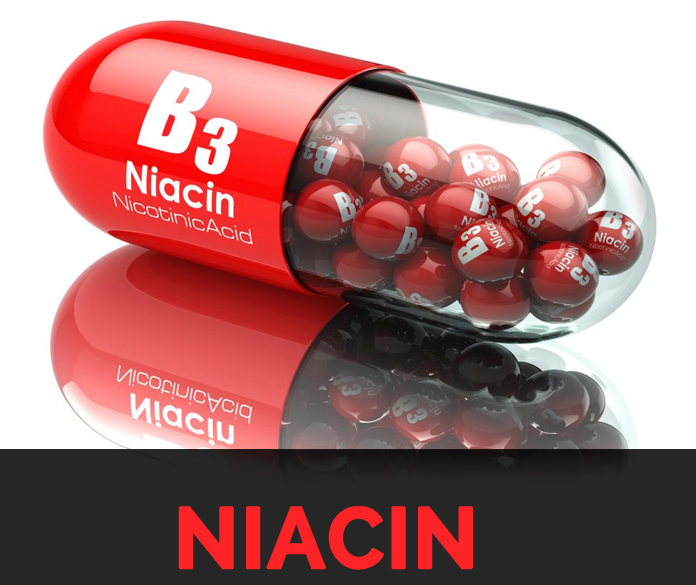Warning: Taking Excessive Vitamin B3 (Niacin) Can Lead To Eye Damage and Blindness
Source: Thailand Medical News Oct 30, 2019 6 years, 1 month, 3 weeks, 5 days, 15 hours, 4 minutes ago
Unknown to many people, taking excessive or above the recommended daily allowance (RDA) of
Vitamin B3 (
Niacin) can lead to a serious eye condition known as
niacin-induced cystoid maculopathy, a form of retinal swelling. If untreated or not diagnosed in time, it can lead to serious permanent eye damage and even
blindness.

Unfortunately, many people take
Vitamin B3 to lower their cholesterol or conditions of
hyperlipidemia. Furthermore, there are some who take
Vitamin B3 to help improve or lighten their complexion and worst are Asian females who take illicit
Vitamin B3 injections to achieve that.
In the first ever clinical report, retina specialists at the New York Eye and Ear Infirmary of Mount Sinai (NYEE) have shown that severe vision loss from a self-prescribed high dose of over-the-counter
niacin is linked to injury of a specific cell type in a patient's eye. The experts report that discontinuing the vitamin in time led to reversal of the condition and have published their findings in the
Journal of VitreoRetinal Diseases.
Dr Richard Rosen, Chief of Retina Services at NYEE and the Mount Sinai Health System and lead investigator in an exclusive interview with
Thailand Medical News commented "People often live by the philosophy that if a little bit is good, more should be better. This study shows how dangerous large doses of a commonly used over-the-counter medication can be. People who depend on vision for their livelihood need to realize there could be long-lasting consequences from inadvertent overdosing on this
vitamin B3."
Dr Jessica Lee, Assistant Professor of Ophthalmology at the Icahn School of Medicine at Mount Sinai and coauthor also commented to
Thailand Medical News "This case serves to remind everyone about the importance of talking to one's physician prior to taking any
supplement, or over-the-counter product. Just because
nutritional supplements are available without prescription does not mean they are completely safe to use without supervision. No matter how benign a supplement or over-the-counter product may seem, the correct dosage and potential interactions with other medications should be carefully reviewed with a doctor, to avoid preventable unexpected consequences. This case illustrates how dangerous casual self-prescribing of megadoses of vitamins can be."
&l
t;br />
The research team from NYEE reported on a 61-year-old patient who arrived at the hospital with worsening blurry vision in both eyes that began a month earlier. The initial exam showed that the patient was almost legally blind, with best-corrected visual acuity of 20/150 in the right eye and 20/100 in the left eye. The patient told doctors his medical history included significant hypertension and
hyperlipidemia, but initially failed to disclose the extent of his self-prescribing. Subsequently, he admitted to taking an extensive list of
health supplements, which included three to six grams of niacin daily for several months to reduce his risk of cardiovascular events and was unaware of the risk to his eyesight. He purchased the supplement at a drug store after a doctor told him he had high cholesterol. The standard dosage is one to three grams a day with a maximum dose of six grams, but doctors typically warn against treating the condition with supplements purchased over the counter and prefer to prescribe and monitor an FDA-approved dose of
niacin.
The clinicians diagnosed the problem using several state-of-the-art technologies, including fluorescein angiography, optical coherence tomography (OCT), and multifocal electroretinography (MERG), to examine his retina for evidence of cellular damage and monitor his response to therapy. Fluorescein angiography uses fluorescent dye to trace blood flow through retinal arteries and veins, looking for leaks. OCT is an advanced structural imaging technique that reveals the cross-sectional details of the retina cells, layer by layer. MERG measures the electrical signals from different layers of cells in the eyes.
The results of the imaging allowed investigators to diagnose a rare toxic reaction called
niacin-induced maculopathy. The high dose of
niacin led to cystoid macular edema of the retina, which is fluid in the macula (a small area in the center of the retina that produces detailed and centralized vision) that causes swelling. The technology also allowed investigators to identify the cellular structures responsible for the patient's condition. The MERG recorded in this case showed reduced b-waves, which indicated that cells affected by the toxicity were the Muller cells, which span the depth of the retina like support columns.
Immediate discontinuation of the
vitamin B3 reversed this effect and restored retinal function and electrical signals. This led investigators to demonstrate, for the first time, that the Muller cells were the target of
niacin toxicity, and the cause of
niacin maculopathy.
Dr Richard Rosen added "While retina specialists have been aware of this unusual reaction to
niacin for many years, such a textbook example of extreme toxicity and recovery has never been as well documented by imaging and functional testing. In this instance the patient was particularly fortunate that the physicians who saw him were alert to the possible cause and were able to confirm their diagnostic suspicions with appropriate testing. This may not always be the case and other patients may not have such a successful outcome."
All individuals are warned that before taking any supplements including
Vitamin B3 or even multivitamins, check with your doctor first and also do some due diligence with regards to the components, doses and the RDA amounts etc
Reference: Jessica G. Lee et al, Optical Coherence Tomography, Fluorescein Angiography, and Electroretinography Features of Niacin Maculopathy: New Insight Into Pathogenesis, Journal of VitreoRetinal Diseases (2019). DOI: 10.1177/2474126419877567
